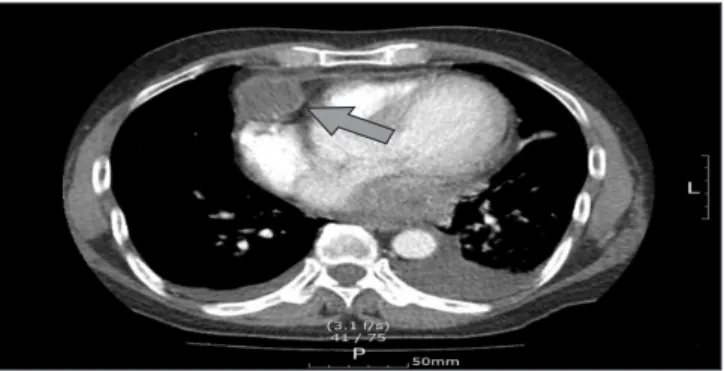101 infect patients with underlying immune compromise, pul- monary disease, or a history of surgery or trauma. Here, we report a case of N. farcinica mediastinitis and pneumonia in an immune-competent patient.
Case Report
A 64-year-old male presented with 1-week history of left chest wall pain. The patient has no significant medical history except hypertension. When chest pain was aggravated and dyspnea was gradually developing, the patient visited another hospital. When the cardiac mass was found on radiologic study, the patient was transferred to our hospital for further evaluation. He was a farmer living in the countryside.
Initial vital signs were as follows: blood pressure, 130/70 mm Hg; heart rate, 78; respiration per minute, 24; and temper- ature, 36.7
oC. Physical examinations revealed normal breath- ing sounds and heart sounds. Left pleural effusion was seen on simple chest X-ray and electrocardiogram showed normal findings. On arterial blood gas analysis, pH 7.450, pCO
234 mm Hg, pO
264 mm Hg, HCO
323.6 mEq/L, SaO
293% was noted.
Introduction
Nocardia is soil-dwelling, gram-positive aerobic actinomy- cete causing a localized or disseminated infection
1. The typi- cal portal of entry of nocardiosis is the respiratory tract with subsequent dissemination to distant organs
1-3.
Nocardia spp. are opportunistic pathogens that commonly
A Case of Nocardia farcinica Pneumonia and Mediastinitis in an Immunocompetent Patient
Jinyoung Kim, M.D.
1, Minkyu Kang, M.D.
1, Juri Kim, M.D.
1, Sohee Jung, M.D.
1, Junhung Park, M.D.
1, Dongkyu Lee, M.D.
1and Heejung Yoon, M.D., Ph.D.
21
Department of Internal Medicine, Eulji University School of Medicine, Daejeon,
2Department of Infectious Diseases, Seoul Metropolitan Government Seobuk Hospital, Seoul, Korea
Nocardia species are aerobic, gram-positive pathogens found worldwide in soil. Nocardia is considered an opportunistic pathogen, and its infection mostly occurs in immunocompromised patients. We report a case of Nocardia farcinica induced mediastinitis and pneumonia that occurred in a 64-year-old male patient who had no significant medical history except for hypertension. He visited another hospital with a complaint of dyspnea and left chest wall pain. The symptoms arose 7 days ago without any trauma and they worsened. A mediastinal mass was found on computed tomography scan. After being transferred to our hospital for further evaluation, he was diagnosed with mediastinitis and pneumonia.
As N. farcinica was found to be the causative organism by 16S rRNA sequencing, proper antibiotic therapy including trimethoprim/sulfamethoxazole was initiated immediately. After this, the patient improved and he was discharged. If an infection has a disseminating course, nocardiosis cannot be excluded even in immunocompetent patients. Once the diagnosis is established, prompt antibiotic therapy should be performed based on the severity.
Keywords: Nocardia ; Pneumonia; Trimethoprim, Sulfamethoxazole Drug Combination
Copyright © 2016
The Korean Academy of Tuberculosis and Respiratory Diseases.
All rights reserved.
Address for correspondence: Heejung Yoon, M.D., Ph.D.
Department of Infectious Diseases, Seoul Metropolitan Government Seobuk Hospital, 49 Galhyeon-ro 7-gil, Eunpyeong-gu, Seoul 03433, Korea Phone: 82-2-3156-3252, Fax: 82-2-383-9559
E-mail: yhj822@eulji.ac.kr Received: Aug. 3, 2014 Revised: Jan. 8, 2015 Accepted: Jul. 1, 2015
cc
It is identical to the Creative Commons Attribution Non-Commercial License (http://creativecommons.org/licenses/by-nc/4.0/).
CASE REPORT
http://dx.doi.org/10.4046/trd.2016.79.2.101ISSN: 1738-3536(Print)/2005-6184(Online) • Tuberc Respir Dis 2016;79:101-103
